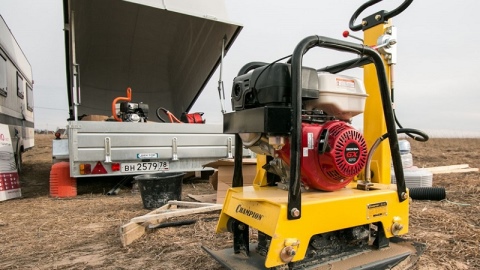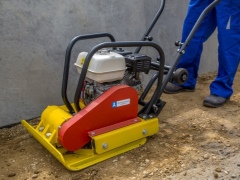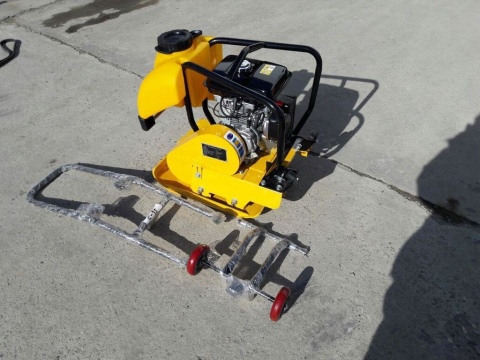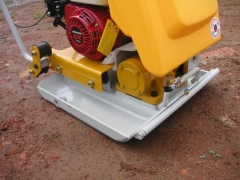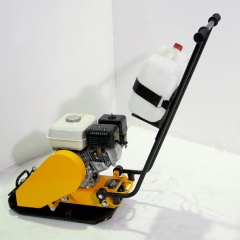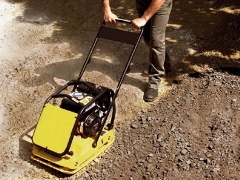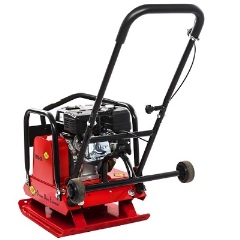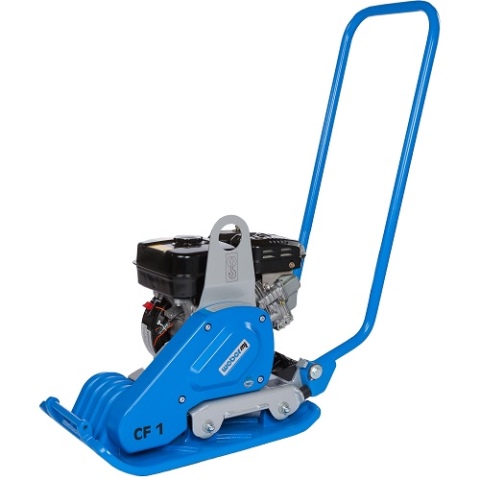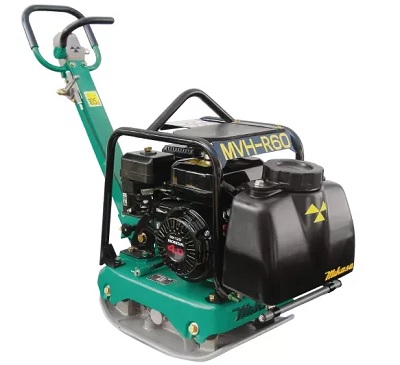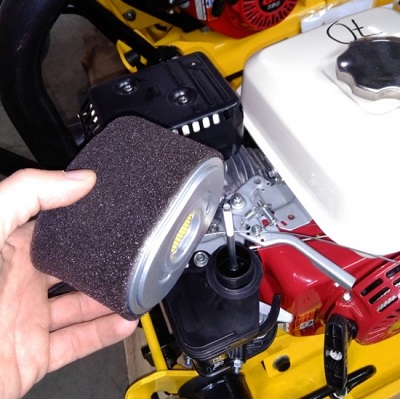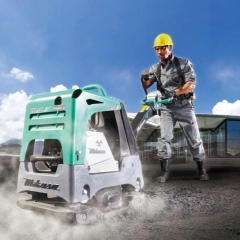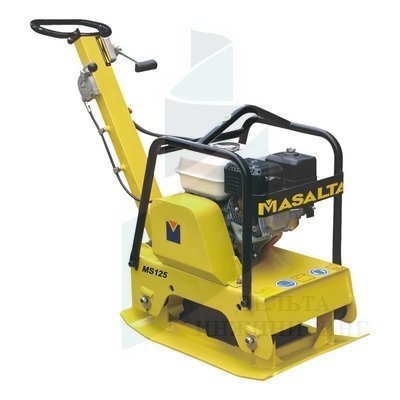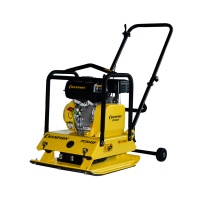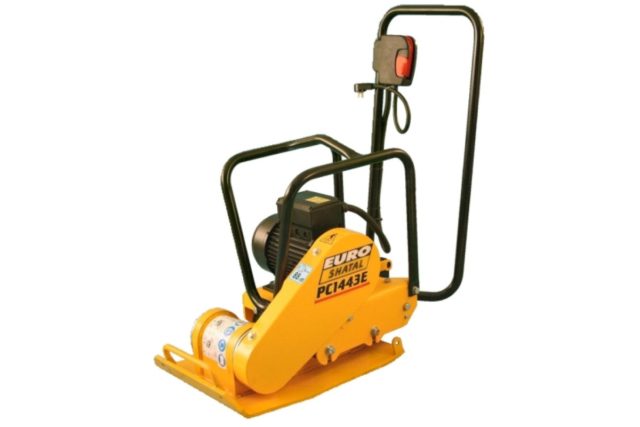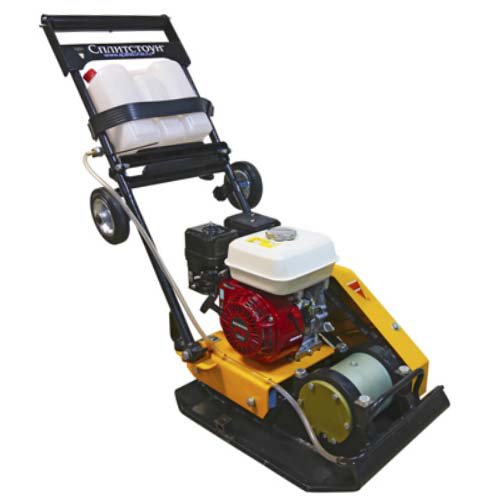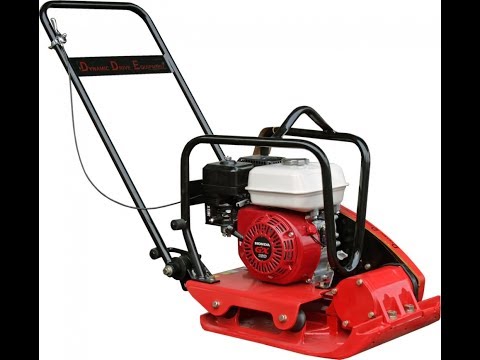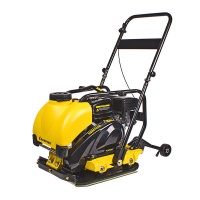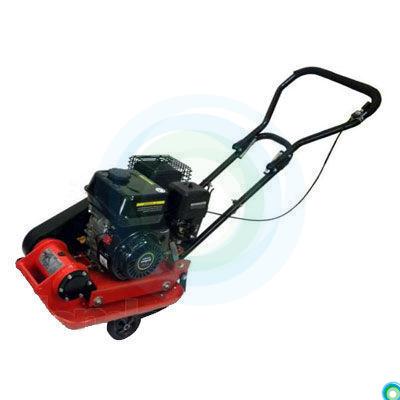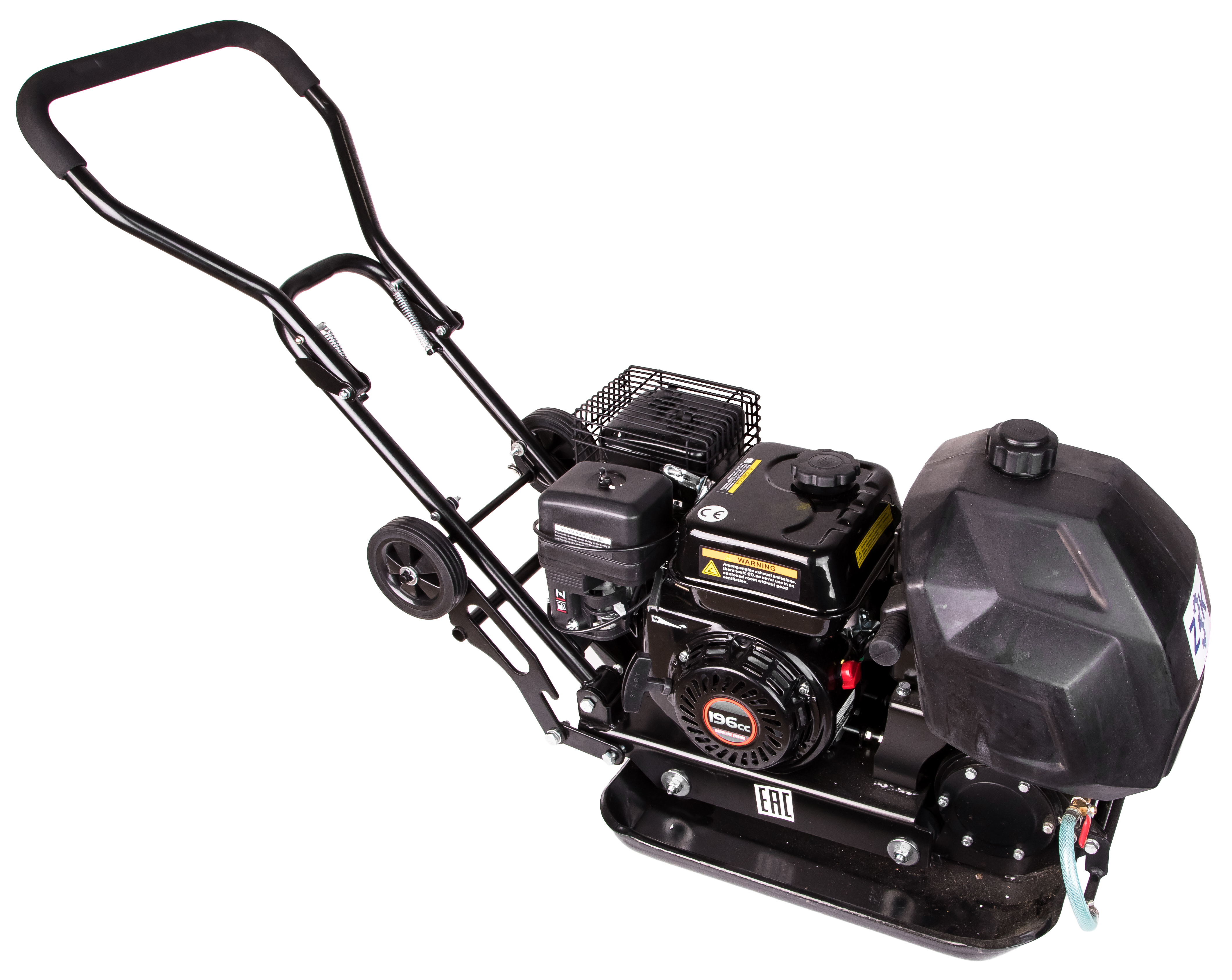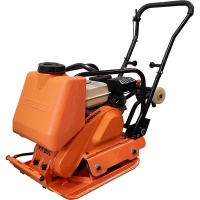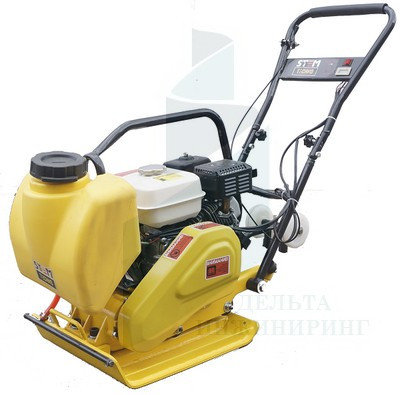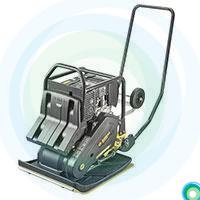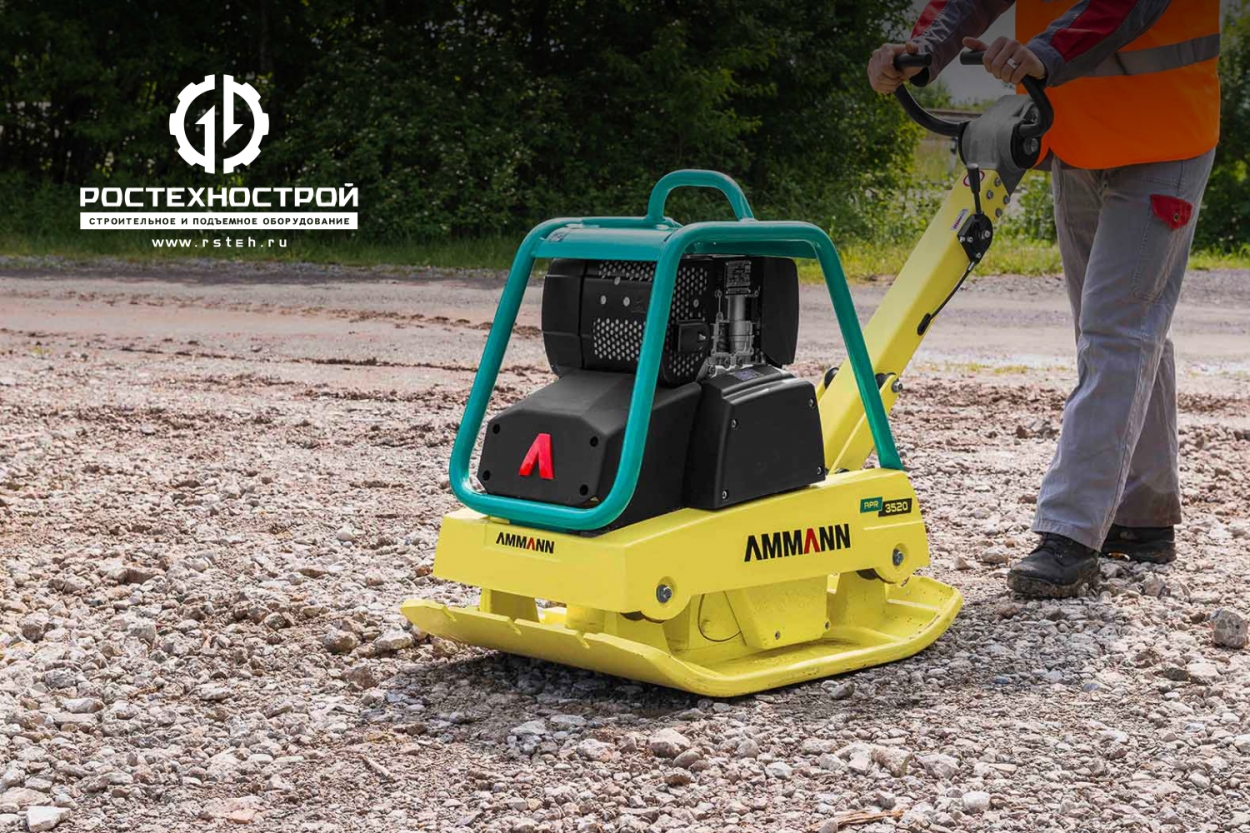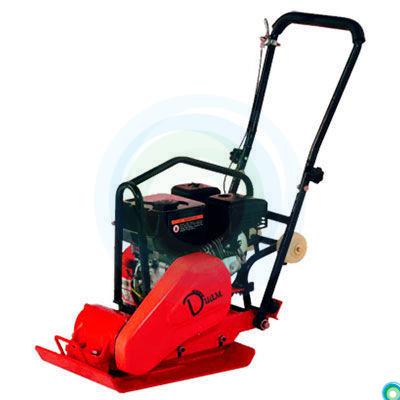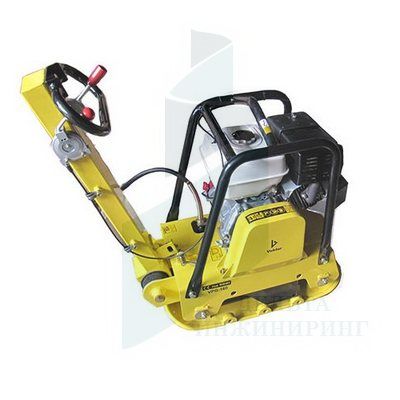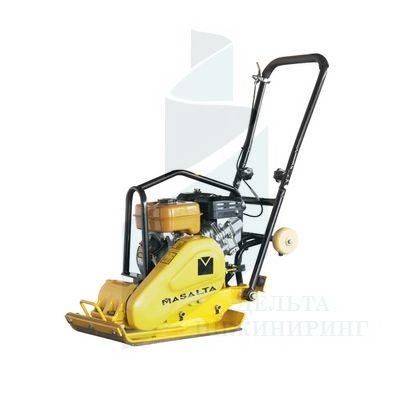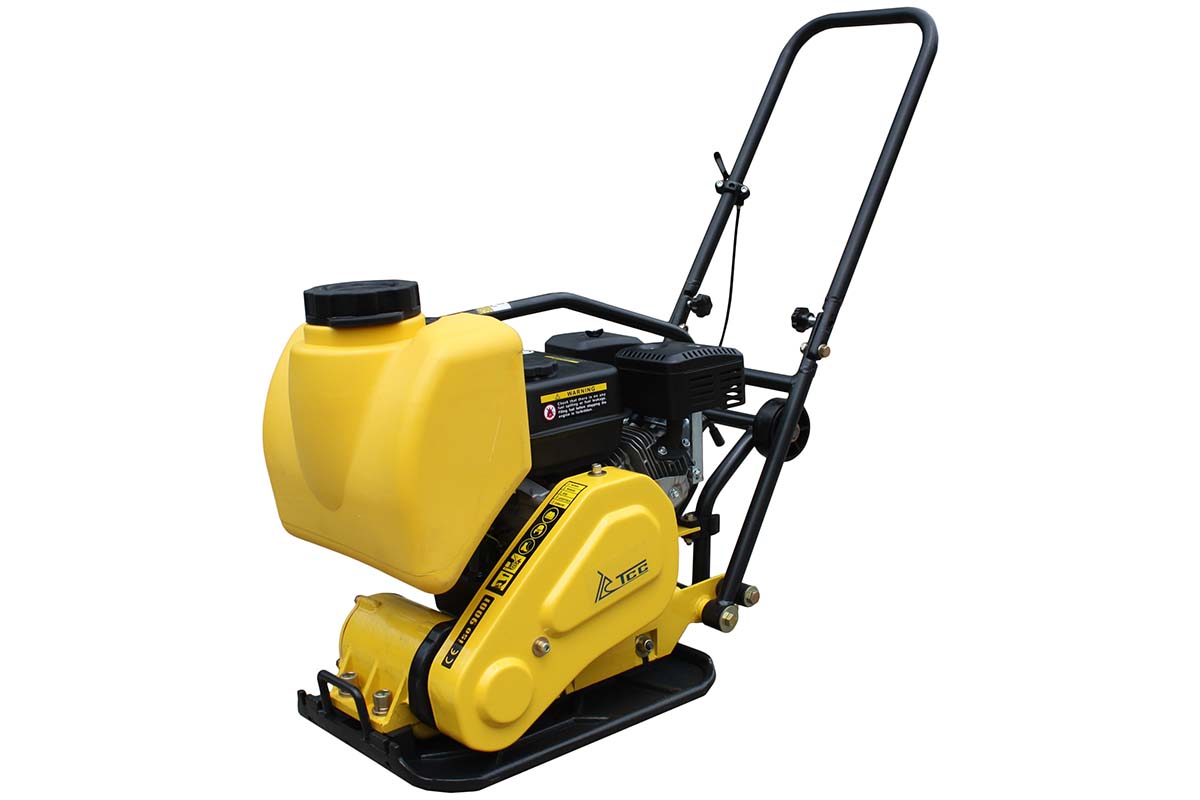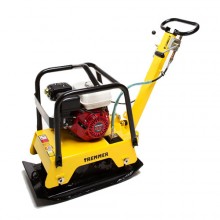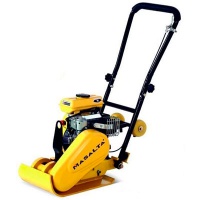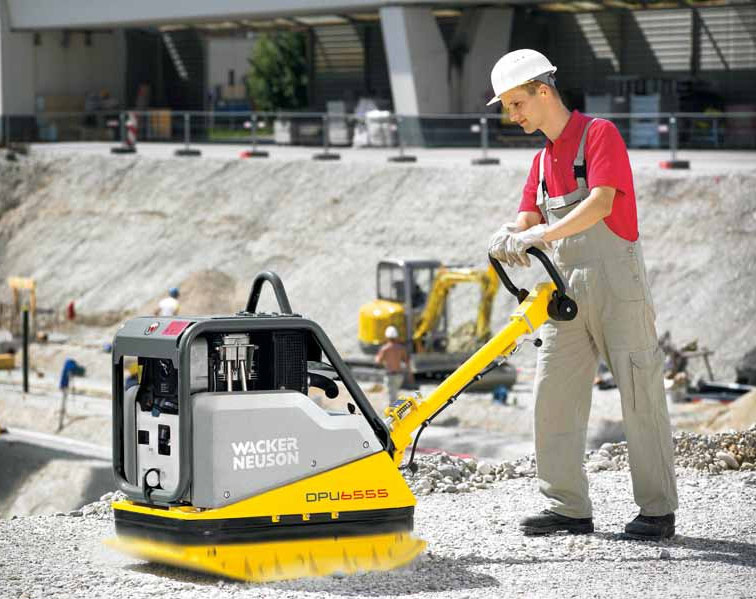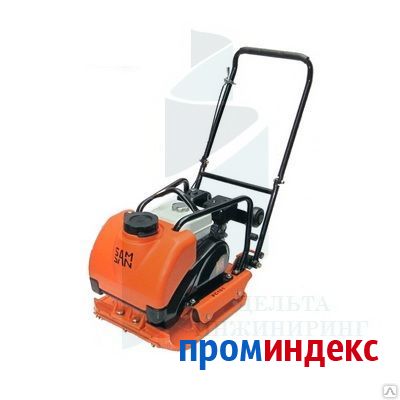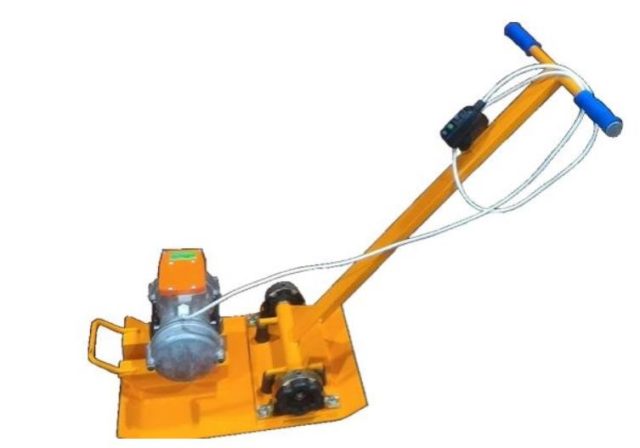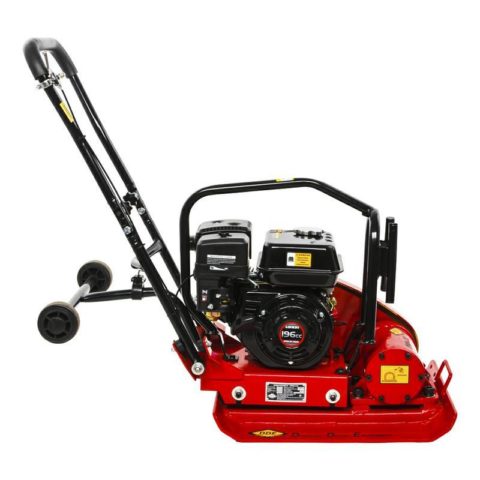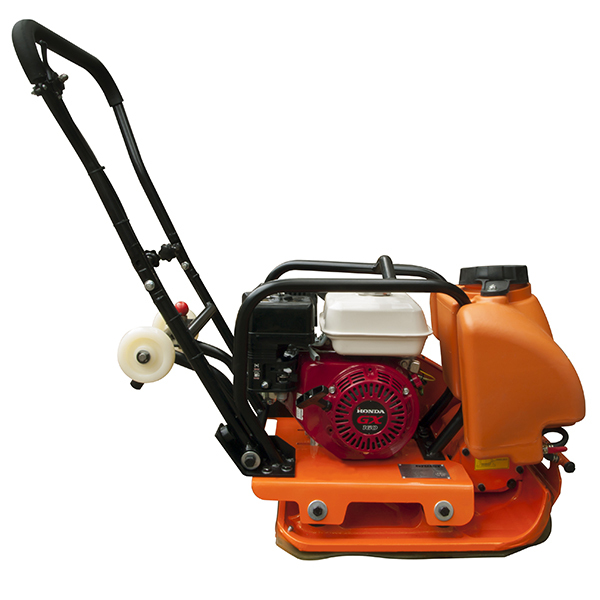Homemade vibrating plate
Factory ramming settings cost a lot. Therefore, some craftsmen prefer to make a vibration compactor on their own. This process will require welding skills and a small set of tools.
Homemade advantages
The cost of a self-made device is much lower than that of ready-made equipment. In appearance, it resembles a walk-behind tractor with a vibration motor. Quality and durability are ensured by simplicity of design. The efficiency of such a vibrator is not lower than that of a purchased one, and sometimes even higher. Advantages of a homemade vibrating plate:
- Full compliance with the working conditions for which it was made, allows you to perform the assigned functions with high quality.
- The owner chooses himself which vibrating plate to make: with an electric motor or internal combustion engine.
- Everyone is also concerned about their own safety on their own. Therefore, all the necessary protection systems will be provided and installed.
- Having your own device will allow you to choose the time and place of work according to your circumstances.
Traction device selection
First of all, it is necessary to decide the question of which type of fuel to prefer. It can be a 220 V vibrating plate made by hand, but its use will be limited. The diesel engine is too noisy and heavy, so it is preferable to stay with a gasoline engine. Such a drive will allow compaction of earth, sand, bulk building materials, tiles and asphalt pavements.
A single or two cylinder engine is suitable to ensure acceptable seal quality. There are many of them on the market. In the more expensive category, the most popular are models from Honda and Kipor, as well as the cheaper Lifan, DDE and Champion.
Materials and fixtures
Everything you need to build a gasoline powered vibratory plate is usually available nearby or inexpensively purchased on the market. Materials to be used:
- Gasoline engine.
- A metal sheet measuring 0, 80 by 0, 45 meters and a thickness of 8-0 millimeters.
- Two pieces of channel.
- 4 bolts 12.
- Grip tube - fits to the palm of your hand.
- Shock absorbers from a car engine.
- 2 wheels.
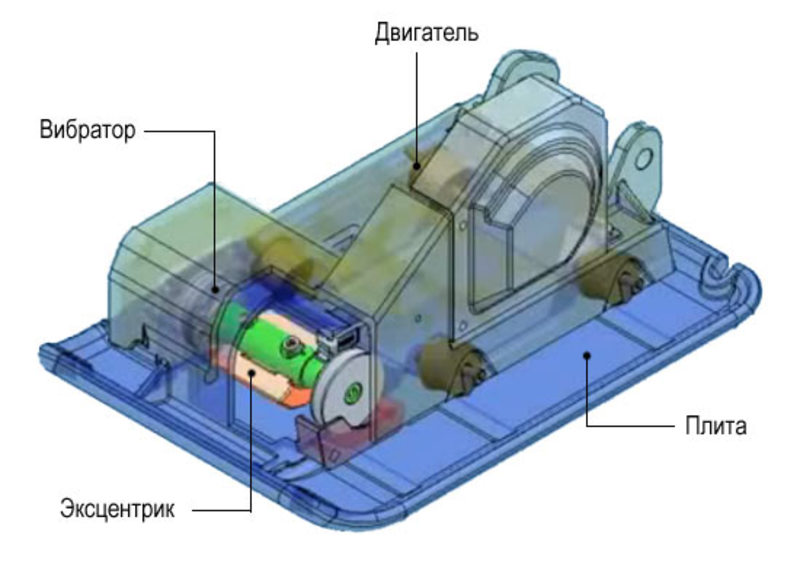
As a last resort, there is such a service as tool rental. Renting the necessary equipment will be inexpensive. Accessories required for work:
- Welding machine and electrodes.
- LBM and discs to it.
- Drilling device (drill or machine).
- A hammer or small sledgehammer.
- Ruler, chalk or scribe, tape measure.
- Protective equipment: welder's mask, goggles, gloves.
Vibrating table manufacturing
First of all, the working platform is made. The edges of the sheet metal must be folded 30 to 40 degrees relative to the ground. To do this, the surface of the plate must be filed 10 centimeters from the edge, no more than half its thickness deep. Then bend along the notch line with a hammer. The seams at the folds must be welded for rigid fixation. Such a sole design will allow the future vibratory plate to slide over the surface, and not bury itself in it.
The most crucial moment is the welding of the channels to the sole. They need to be measured exactly according to the size of the plate and welded, focusing on the center - so that there are 70—00 millimeters between them. To prevent the stove from leading, the material to be welded should not be overheated. For fastening, it is necessary to mark the channel according to the motor mount. You can simply attach it to the channel runners and mark the points with chalk or a marker.You can also measure these distances with a tape measure. After drilling the hole, the motor is put in place and bolted in place.
Safety at work
The compaction of the soil with a vibrating plate must be carried out in compliance with safety precautions. Among the many recommendations, the following basic rules can be distinguished.
- During work, it is necessary to apply individual protection means
: Appropriate clothing and footwear, glasses, headphones, headwear. - Before starting operation, you need to check the used equipment for external damage: if any, then they must first be repaired.
- It is forbidden to leave the operating equipment unattended, while the operator must be located behind him and move behind the machine in a timely manner.
- A break of about 10 minutes should be organized every 40 minutes to prevent operator fatigue.
- It is impossible to further accelerate the mechanism by applying additional efforts.
- If you need to work on an inclined surface
(when the angle does not exceed the norm), the maintenance personnel must stand above the unit, moving from top to bottom. - It is forbidden to operate the technical device near sources of explosive or flammable materials.
- At overturning vibratory plate
, it should be turned off first, and only then put into working position. - It is worth deploying the unit with one hand.
- To prevent injury, keep your feet and hands away from the working sole of the plate.
- In the event of a collision with any obstacle, you need to stop the unit, and then remove the obstacle and possible breakdowns caused by it.
- From the edges of trenches, pits, ravines and other recesses, it is required to be no closer than at the minimum permissible distance, but better - further away.
- It is strictly forbidden to allow people under the influence of drugs, alcohol, psychotropic drugs to work.

It should be borne in mind that the higher the center of gravity of the vibration equipment (and the smaller the support area), the easier it can turn over.
It is very dangerous for the operator.
Also, be very careful when turning on appliances that are not equipped with a soft start function.
The use of a vibrating plate is required when carrying out all construction activities that are associated with the compaction of loose soils. It is imperative to take into account the features of the rammed materials in order to achieve a quality result. It is necessary that the maximum depth of the poured layer corresponds to the thickness that the operating unit is capable of tamping. In any case, safety must come first. Failure to follow simple rules, coupled with carelessness, can lead to serious injury.
To give the building maximum stability, you need to carefully tamp the sand at the base of the foundation - this will protect the building from water and shrinkage.
Such a pillow can be made of concrete or rubble, but most builders choose sand.
High-quality compaction of sand is a guarantee of a durable base.
Before the start of tamping, the thickness of the future cushion is determined, which will be necessary for the foundation of the building. The sand layer can be from 10 to 30 mm, but this factor completely depends on the mass of the future building - the more weight, the thicker the layer should be. If the sand base is for a road or site, the thickness should be about 150 mm.
Manufacturing options for basic elements
The design of the vibrating plate is quite simple. It consists of four main nodes:
- engine;
- plates;
- frames;
- vibrator.
Engine
As a drive for a homemade vibrating tool, you can use:
- electric motor;
- gasoline or diesel internal combustion engine (ICE).
The electric motor for the vibrating plate, which is planned to be assembled, is recommended to be selected with a capacity of 1.5 to 2 kW. In this case, the rotation speed should be from 4000 to 5000 rpm. If the power of the electric motor is less than the specified value, this will affect the performance of the created unit in the direction of its decrease.
The electric motor is the most expensive part of a DIY installation. For home use, it is better to buy single-phase modifications of electric motors, for example, as part of IV-99E or IV-98E vibrators, operating from a voltage of 220 V. The electric motor can also be removed from old unused equipment, for example, from a drilling machine. It is only necessary that it match in terms of power and speed.
If you equip home-made equipment with an electric motor, then to increase the safety of work, it is recommended to install separately protection, for example, a differential circuit breaker or a residual current device (RCD).
A homemade vibrating plate can also be equipped with an internal combustion engine. If you buy it, it is recommended to give preference to Honda's single-cylinder three-stroke engines. Internal combustion engines from a chainsaw or walk-behind tractor are also suitable.
Plate and frame
From the engine, the movement is transmitted to the vibrator by a belt - it is mounted on the pulleys. By changing the dimensions of the latter (diameter), you can set the required speed of the vibrator. A car belt is suitable for a belt drive. The plate is made of steel or cast iron sheet with a thickness of 8-10 mm. The rest of the structure is located above it. To make the frame, use metal corners 5 by 5 cm or larger.
Vibrator
A vibrator for a vibrating plate can be purchased factory-made or made independently in various ways. One of the options for a homemade vibration unit will be discussed in the next paragraph.
Additional structural elements
Light (up to 75 kg), universal (75-90 kg) and medium-heavy (from 90 to 140 kg in weight) models of equipment without the possibility of remote control are equipped with handles made of metal pipes. With their help, the operator sets the direction of movement.
For ease of transportation, the units are also equipped with wheels. They can be removed if necessary. To move a homemade stove, you can take wheels, for example, from an old wheelbarrow.
Self-production
The vibrating plate is a simple device, which is why many decide to make this unit on their own. To make a vibrating plate with your own hands, you will need a small amount of materials and skillful hands.
You can make a vibrating plate yourself in several ways. One of them is to buy a pad vibrator. Such a purchase will facilitate the creation of the unit, since you will not need to mount the eccentric, and all you need to do is make a plate and attach the purchased vibrator to it. If this method suits you, then when buying a vibrator, choose a 220V motor, because three-phase power is not available in all areas.
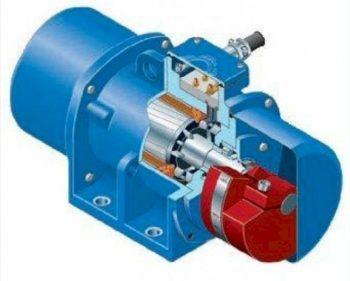
The second way is to use an old electric motor. In this case, you need to take care of the installation of the eccentric. If you make a gasoline vibrator, then the engine can be used as a single-cylinder two-stroke.
The main part of the device is a heavy metal platform. To make it yourself, you need a thick steel sheet with a thickness of 8-10 mm
Why not cast iron? Because it is easier to work with steel and it is not subject to chips, which is important when making the unit yourself
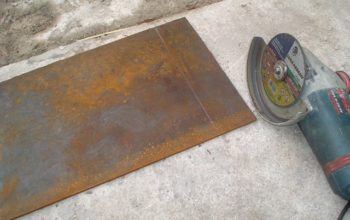
Be sure to pay attention to the thickness of the sheet, the strength of the structure and sufficient weight, up to 60 kg, depend on this. The dimensions of the platform in the standard are 80x45 cm
Such an area will be enough for a large number of works, in addition, this is reflected in the productivity and mobility of the device.The tamping depth indicator of such a self-made tool is 15-20 cm, and this is enough for summer cottages.
Before assembling the vibratory plate, you need to prepare:
- Short channels (2 pcs.) - they will need to be welded to the site;
- Engine - attached to channel bars;
- Eccentric - if necessary;
- Fastening bolts and nuts;
- Hollow tube for handle;
- Elastic rubber pads are used to mount the motor and handle.
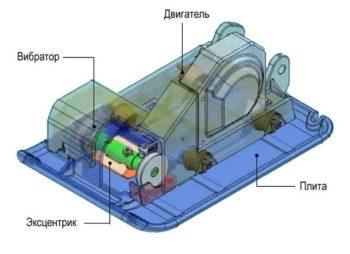
It is also necessary to have basic locksmith tools, a grinder and an apparatus for welding parts.
Assembly Algorithm
For the manufacture of equipment, precise drawings are not used, but everything is done according to a schematic diagram, making corrections for materials and capabilities.
The sequence of actions for assembling the vibrating plate:
- Preparing the plate. Initially, a rectangular area for the slab is cut, in which the front and rear edges are folded. This is necessary so that during operation the slab does not burrow into the ground, and the work is carried out without difficulty. To bend the edges of the sheet evenly, measure 10 cm from the edge and file shallowly with a grinder. Each fold is done 30 degrees. You can use a hammer to do this. Welding is used to fix the cuts and bends.
- Fastening the engine seat to the plate. It is necessary to weld two channels to the site, which were originally equipped with mounting holes for the eccentric (if necessary), the handle and the motor.
- We fasten the electric motor and eccentric. It is permissible to use rubber gaskets, which reduce the vibration load on the motor.
- Handle attachment. Rubber pads can be used to minimize the transmission of vibration to the hands during operation.
- The last stage is setting the eccentric. It is necessary to remove the cover and set the weight in the desired position in accordance with the scale.

It is important to note that if the equipment is manufactured for compacting asphalt, it is imperative to install an irrigation system. To make it, you can use a canister with a hole that resembles a watering can.
In the front of the platform, it is enough to make a temporary attachment and attach the container. Make sure that the position of the canister is correct so that no water gets onto the mechanism. Before starting work, the container must be attached to the equipment, and then filled with water. Thanks to this detail, the adhesion of the unit to the asphalt will be minimized.
Operating tips
As a rule, the manufacturer indicates in the technical documentation for the manual vibratory rammer the useful life of the device equal to 3 years. During this time, it is necessary to carry out preventive inspections - to fill the engine with oil in a timely manner, change the brake linings and carry out maintenance of the clutch, if necessary - change the connecting rod, and so on.
Equipment that meets technical standards is capable of compacting the soil to the depth indicated in the data sheet. But at the same time, it is recommended to monitor the level of fuel consumption - on average, fuel consumption should not exceed 1.5-2 l / h.
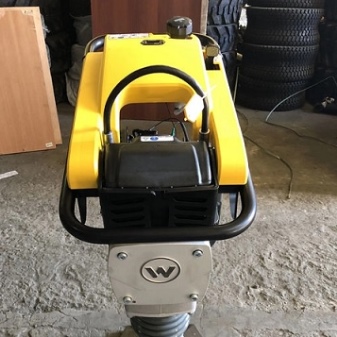

In the next video, you will find a detailed review, advantages and test of the Vektor VRG-80 gasoline vibration rammer.
Description of species
A manual vibrator is a convenient and productive tool, its choice depends on the volume and characteristics of the work to be done. There are 2 types of such devices.
Straight travel
The non-reversible type of rammer machine can only move in the forward direction. Their speed and, as a consequence, the productivity of the work are regulated by the operator, which makes it possible to achieve the greatest depth of compaction of the treated surface. In order to move the vibratory plate in the opposite direction, the operator will have to turn it around on his own.
Reversible
The type of rammer that can move forward or backward is called reversible.These are the most convenient devices that are used for uniform compaction of soil, even in confined spaces. The reversible movement of these machines is extremely accurate, so that the operator does not need to correct the direction of movement of the vibratory rammer manually. The only drawback of such equipment is its heavy weight and rather high price.
All vibratory rammers are equipped with an engine and, depending on its type, are divided into the following types.
Gasoline powered. A gasoline engine is the most economical option in terms of fuel consumption, and a gasoline unit is cheaper than other analogues. Gasoline vibrating plates are not tied to a power point, therefore, they can work in autonomous mode and move freely at any distance. In addition, gasoline-type units have proven themselves well when operating in a wide range of plus and minus temperatures. The disadvantage of gasoline units is their heaviness and creating noise during operation.

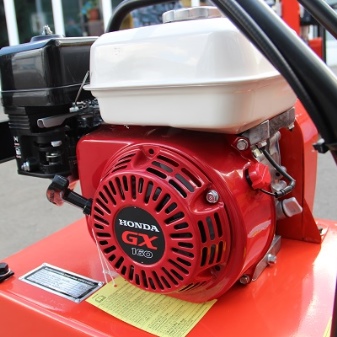

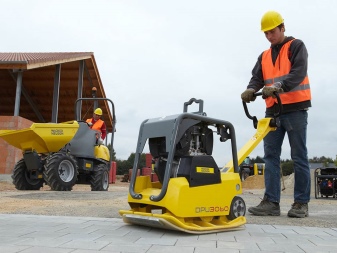
Among users, the most popular are gasoline-type units, since today they are the most economical equipment that works in all-weather conditions.
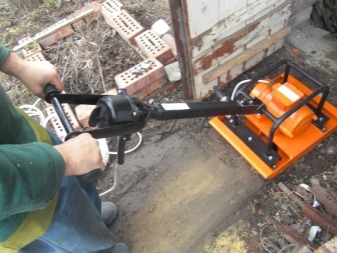
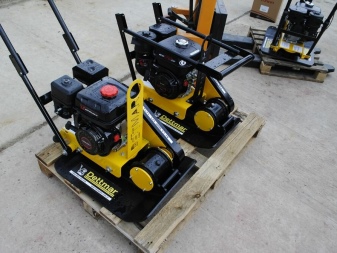
How to do it yourself: step by step assembly
Consider the process of how to make a homemade vibratory plate for soil compaction yourself. Procedure:
With the help of a grinder, a plate (base) is cut out. The size is chosen based on your own ideas, it is recommended to adhere to an average value of 60 * 40 cm.
At the edges, cuts are made at a distance of 7 cm (front) and 5 cm (back), to a depth of about 5 mm. Along the line of cuts, the edges are bent upward by 25 ° so that the plate does not cling to the ground and does not get stuck.
Two pieces of channel are welded to the top of the slab, reinforcing the base and edges. It is necessary to ensure that they are in the same plane.
From the rear side, holes are drilled in the channels or burned with a welding electrode for mounting the motor. If necessary, a metal platform with mounting holes is pre-welded.
The engine is installed using rubber mountings.
The lugs are installed for attaching the handle.
The rotor with an eccentric is manufactured separately and installed on the plate in a finished (assembled) form. It is a shaft mounted in a hub. One of them is deaf, the second is a checkpoint. A section of the shaft passes through it, on which the pulley is installed. The pulleys must be aligned or the drive belts will have to be changed every shift.
The tensioner attaches to the frame in a convenient location. It is usually installed in the middle, between the pulleys, at the point of maximum belt sag.
It is important to ensure that all pulleys and idler pulley are in the same plane.
It is recommended to cover the rotating rotor with a protective cover to prevent injury.
The handle is installed, a test run of the vibrating plate is carried out, the operability is checked. The detected problems or flaws are eliminated, the necessary corrections are made.
The start-up of the vibrating plate is possible only after the complete elimination of all deficiencies. Rarely does anyone manage to get the expected result the first time, but after fixes, the installation usually starts working in the desired mode. The main setting is to determine the optimal eccentric value and select the high-speed operating mode.
A homemade vibratory plate, whatever it turns out, will provide a much better result than trying to tamp the backfill layer by hand. All discovered shortcomings will be eliminated, as the operation progresses, there will be additions or improvements to the design. The final result is capable of competing with industrial designs, if not outstripping them in efficiency and quality of work.
The main advantage of home-made devices is the ability at any time to correct or change the design, add additional elements. With ready-made vibrating plates, such actions are impossible, since the design of such technical means rarely allows you to make changes. The quality and speed of labor-intensive bulk material handling deserves the time and effort spent building homemade machines.
Vibrating screed assembly algorithm
For the implementation of the simplest options, drawings are not needed. Suitable as a drive unit:
- Sander;
- Bulgarian;
electric drill or screwdriver.
You will also need the following working tools and materials:
- smooth, polished board 0.5 m long, about 3 cm thick, 25 cm wide;
- self-tapping screws;
- punched tape;
- bar 5 by 5 cm, length 1-1.5 (2 pcs), to make a handle.
A vibrating screed from an electric drill in the form of a mop is assembled in the following sequence:
- the surface of the board (if it is not sanded) is made smooth using a planer and sandpaper;
- to it from above exactly in the center, using punched tape and self-tapping screws, fix the electric drill laid along;
- on both sides of the drill, stepping back a few centimeters, attach the handle at an angle, cutting off the ends of the bars obliquely;
- fix in the chuck of the power tool a nozzle, the center of gravity of which is displaced, for example, a clamping wrench, a curved drill or a piece of reinforcement;
- connect the unit to the network and check its operability.
The drill chuck should rotate about an axis that coincides with the center longitudinal line of the board. Vibration occurs due to the use of a nozzle with a displaced center of gravity.
A vibrating screed from a grinder, grinder or screwdriver is made in a similar way. Only after compacting and leveling the concrete will the power tool need to be well cleaned of the mortar so that it can be used in the future.
If you need to compact and level the concrete with a layer of up to 10 cm, then a vibrating screed from a deep vibrator will do. It is made as follows:
- a rectangular sheet is cut out of plywood (with a side length of about 70x50 cm);
- a mace is attached to it with punched tape or with the help of clamps, while the deep vibrator itself serves as a kind of handle.
In order for the rail to move freely, it is better to cover the working surface of the plywood rectangle with tin folded along the edges.

